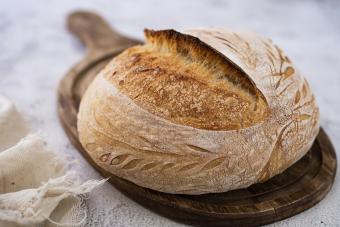
Culinary herbs can be a bit confusing if you are new to using herbs in the kitchen. Fortunately, there is help available from books and other resources. One such resource is Master Gardener Sallie Scribner. Sallie handles the greenhouse at Summer Winter Restaurant in the Boston Marriott Burlington Hotel in Burlington, MA. One of her duties there is caring for over 60 varieties of culinary herbs. As you can imagine, Sallie has many tips to share on the use of culinary herbs.
Herbs in the Kitchen
LoveToKnow (LTK): Which herbs are most commonly used in the kitchen?
Sallie Scribner (SS): I'd say the most common fresh herbs used in the kitchen in the United States are basil, parsley, thyme, sage, rosemary, cilantro and mint. I think the popularity of these herbs changes with the season - for instance, summer dishes tend to lend themselves easily to basil and cilantro whereas winter dishes lend themselves easily to thyme and rosemary.
LTK: Which herbs seem most forgotten in the kitchen and why should they be used more?
SS: There are quite a large number of herbs that I rarely see, but that are so much fun to grow in the garden and use in the kitchen! I am especially fond of scented geraniums, whose leaves and flowers are scented with lemon, rose, ginger, or other fragrances. These leaves can be used in teas or in baking, where they impart a lovely essence to the dish. I am also fond of the different types of sage, including pineapple sage whose leaves smell strongly of pineapples and can be used in fish dishes or muddled in drinks. Finally, I am a huge lavender lover. The smell and flavor of fresh lavender lends itself very well to drinks or desserts, and the purple flowers add a lovely element to the presentation of a dish.
LTK: Some herbs have many varieties, such as the many types of mint. How can a home cook take advantage of all these different versions of the same herb?
SS: There are many herbs with a wide array of varieties, with mints and basils topping my list as far as number of unique varieties. In the world of mint, there are numerous varieties: spearmint, peppermint, chocolate mint, pineapple mint, apple mint, citrus mint, and the list goes on. The world of basils is even more complex, with each variety boasting a different combination of scent, texture, leaf shape, size, and color.
Finding uses for each of these herbs can take some creativity in stepping outside the bounds of ordinary cooking. For instance, different flavors of mint can be used for different flavors of mojitos, tabbouleh, or flavorful potato dishes, and you can even make candied mint leaves to top a dessert.
As for basil, it can be paired not just with tomatoes, but also with eggplant. Furthermore, we all know that pesto is a great use for basil, but what about using purple basil to make your pesto more colorful? Thai basil ice cream is another unusual and delicious idea. My suggestion is to experiment, and you just might discover an amazing new alternative use for an otherwise common herb.
Recognizing Herbs
LTK: What are some ways that a gardener/home cook can learn to recognize various cooking herbs?
SS: By far the easiest way to begin to recognize various cooking herbs is to begin growing them yourself! When you are face to face with an herb every day and you are taking care of it, you will naturally become an expert at identifying it.
I would also suggest growing annual and perennial herbs from seed - when you can start these herbs from seed, you are able to grow a lot more than what you can find at a typical nursery. You will really impress yourself when you can distinguish between English and French lavender, or between Christmas basil and Queenette basil.
If you want to hone your herb identification skills more broadly, I would suggest visiting the herb section of your local nursery, or perusing the seed catalogs of companies that focus on herbs.
LTK: What is the easiest way to identify an herb that may not be immediately recognized?
SS: If you know a little bit about plant families, you may be able to determine whether the plant in question is, for instance, a mint or a sage. Mint is in the plant family Lamiaceae. Plants in this family typically have a square stem and whorled leaves. However, the Lamiaceae family is big, and contains not only mint but also oregano! So how can we distinguish between oregano and mint? The easiest and quickest way is to crush a leaf in your hand and take a whiff!
LTK: Which herbs are easiest to identify and why?
SS: The easiest herbs to identify are obviously those that look the most strikingly different. Lemongrass comes to mind. The long stalks, plus the intense lemon fragrance that permeates the air once you peel back the outer layers of the husk makes this herb unmistakable.
LTK: Which herbs are similar and may be difficult to differentiate? What tips can you offer to accurately identify these herbs?
SS: Cutting celery, lovage and parsley are by far the most similar-looking herbs that I grow. Guests who visit my greenhouse can rarely tell the difference, unless they are placed side by side, and then the subtleties of leaf shape, color, and stalk size become more apparent. The only tip I can offer to accurately identify these herbs is through your tastebuds.
Shiso is becoming a more popular herb these days, especially in Asian cuisine. Shiso looks very similar to mint and tastes like a delicate mint with a cucumber undertone. The best way to differentiate shiso from mint is the leaf size and texture. Shiso typically has bigger leaves than mint, the leaves are more tender, and the edges of the leaves are "toothed."
LTK: Are there any herbs that resemble other plants that should not be consumed?
SS: Kaffir lime trees look very similar to normal lime trees. With the Kaffir lime tree, however, the leaves are what is consumed and used as an herb, rather than the fruit. You would not eat the leaves of an ordinary lime tree.
Handling and Using Herbs
LTK: What is the best way to handle culinary herbs after harvesting them?
SS: After harvesting your herbs, keep them out of direct sun and heat. You may take the cut stalks of herbs like cilantro, parsley, and basil, bunch them up like a bouquet and place them in a jar of cool water on your counter or in your fridge.
If your basil is about flower, you will want to make sure to harvest the whole plant before it does! Once basil flowers, the taste of the leaves is completely altered. If you are harvesting a bunch of basil at once, chances are you won't be able to use it all at once. In this situation, I would take a handful of the leaves, blend them in your food processor with a little bit of extra virgin olive oil, and freeze them in ice cube trays for use in recipes later on.
LTK: What are some of your favorite uses for culinary herbs?
SS: In the summertime, nothing beats the freshness of ice water with muddled mint leaves and a slice of lime. This is my drink of choice for long days working in the garden.
I also really enjoy using fresh bunches of herbs in salads and sandwiches. Cilantro works wonders in an otherwise simple hummos pita. Fresh basil leaves disguised in a salad are like hidden treasures of flavor.
Finally, I'm a proponent of using the flowers of the herbs. For most herbs, you want to make sure to harvest them before they flower; however for other herbs like pineapple sage with its bright red flowers, lavender with its purple spiked flowers, and chives with their spicy pink flowers, the flowers add beauty and intense flavor to a dish. I would recommend adding them fresh or, if you're making a cocktail, freezing them in an ice cube makes for a lovely presentation.
Identification Help
For more help identifying culinary herbs, download the Herb Identification Chart available from Epicurious. It is a helpful start as you learn more about herbs.
With just a few tools and lots of practice, you'll be a pro in no time.
LoveToKnow would like to thank Sallie Scribner for her tips on using and identifying culinary herbs.







